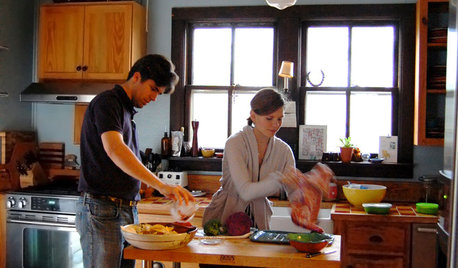How to gather enough stuff? (Newby question)
tomatotomata
12 years ago
Related Stories

MOST POPULARA Fine Mess: How to Have a Clean-Enough Home Over Summer Break
Don't have an 'I'd rather be cleaning' bumper sticker? To keep your home bearably tidy when the kids are around more, try these strategies
Full Story
KITCHEN DESIGNTrending Now: 25 Kitchen Photos Houzzers Can’t Get Enough Of
Use the kitchens that have been added to the most ideabooks in the last few months to inspire your dream project
Full Story
ORGANIZINGPre-Storage Checklist: 10 Questions to Ask Yourself Before You Store
Wait, stop. Do you really need to keep that item you’re about to put into storage?
Full Story
KITCHEN DESIGN9 Questions to Ask When Planning a Kitchen Pantry
Avoid blunders and get the storage space and layout you need by asking these questions before you begin
Full Story
FEEL-GOOD HOMEThe Question That Can Make You Love Your Home More
Change your relationship with your house for the better by focusing on the answer to something designers often ask
Full Story
WORKING WITH PROS12 Questions Your Interior Designer Should Ask You
The best decorators aren’t dictators — and they’re not mind readers either. To understand your tastes, they need this essential info
Full Story
MOST POPULAR8 Questions to Ask Yourself Before Meeting With Your Designer
Thinking in advance about how you use your space will get your first design consultation off to its best start
Full Story
WORKING WITH PROS9 Questions to Ask a Home Remodeler Before You Meet
Save time and effort by ruling out deal breakers with your contractor before an in-person session
Full Story
ENTERTAINING8 Stress-Busting Tips for Hosting Small Gatherings
Make entertaining easy with these ideas for casual get-togethers
Full Story
FEEL-GOOD HOMEThe Well-Stocked Minimalist
The trick is to have just enough of the right stuff at home — no more, no less. Here’s how to do it
Full Story







bi11me
hortster
Related Professionals
Wrentham Landscape Architects & Landscape Designers · Erie Landscape Architects & Landscape Designers · Havre de Grace Landscape Architects & Landscape Designers · Mountain Brook Landscape Architects & Landscape Designers · Willowick Landscape Architects & Landscape Designers · Brookside Landscape Contractors · Eagle Landscape Contractors · Hampton Bays Landscape Contractors · Pahrump Landscape Contractors · Hueytown Landscape Contractors · Harrisburg Decks, Patios & Outdoor Enclosures · North Aurora Decks, Patios & Outdoor Enclosures · Olathe Decks, Patios & Outdoor Enclosures · Pittsburgh Decks, Patios & Outdoor Enclosures · Statesville Decks, Patios & Outdoor Enclosureshortster
ralleia
praxxus55712
Laurel Zito
ralleia
tn_gardening
mean_74
toxcrusadr
billums_ms_7b
Laurel Zito
tomatotomataOriginal Author
robertz6
jolj
ralleia
bi11me
tn_gardening
Laurel Zito
organic_popeye
ZoysiaSod
bi11me
flora_uk
wayne_5 zone 6a Central Indiana
robertz6